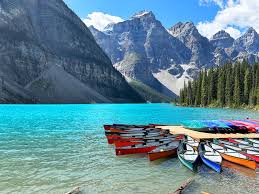Banff Nature Tours
Discover alpine ecosystems, wildflowers, and pristine wilderness with naturalist guides!

Immerse yourself in Banff's extraordinary natural ecosystems with expert naturalist guides! Nature tours explore diverse habitats from montane valleys to alpine tundra, showcasing wildflowers (July-August peak), ancient forests, pristine lakes, glaciers, and geological wonders. Learn about plant adaptations to harsh mountain climates, how glaciers carved the landscape, predator-prey relationships in wildlife communities, and Indigenous traditional ecological knowledge. Tours include interpretive hikes to alpine meadows, lake ecosystems, forest ecology walks, and geological interpretation. Discover why Banff is a UNESCO World Heritage Site, understand conservation challenges, and witness nature's resilience. Seasonal highlights include spring wildflowers, summer alpine blooms, fall colors, and winter ecology. It's nature education combined with breathtaking Canadian Rockies scenery!
Why Choose Nature Tours in Banff?
UNESCO Wilderness
Explore World Heritage landscapes with incredible biodiversity!
Expert Naturalists
Certified guides share ecological knowledge and conservation insights.
Wildflower Displays
July-August alpine meadows burst with color - spectacular!
Educational Experience
Learn about ecosystems, geology, and nature's interconnections.
Types of Nature Tours in Banff
Alpine Wildflower Tours
Hike to high alpine meadows seeing peak wildflower displays.
Forest Ecology Tours
Explore ancient forests learning about trees, fungi, and forest communities.
Lake Ecosystems Tour
Study glacial lakes, aquatic life, and water chemistry creating turquoise colors.
Geological Interpretation Tour
Understand mountain-building, fossils, and rock formations with geologist.
What to Expect on Your Banff Nature Tours
Duration
Half-day tours: 3-4 hours. Full-day: 6-8 hours with lunch breaks.
Wildflower Meadows
See 900+ plant species including rare alpines blooming July-August.
Alpine Ecology
Learn how plants and animals survive extreme high-altitude conditions.
Glacial Features
Understand glacial processes, moraines, and how ice shapes landscapes.
Forest Ecosystems
Discover ancient trees, mycorrhizal networks, and forest succession.
Conservation Lessons
Learn about Parks Canada conservation, climate change impacts, and stewardship.
Expert Tips for the Best Experience
July-August peak wildflower season - Sunshine Meadows and Paradise Valley best spots.
Bring hand lens or magnifying glass for close-up plant observations.
Wear sturdy hiking boots and dress in layers - alpine weather unpredictable.
Download plant identification apps (PictureThis, iNaturalist) to continue learning.
Bring field guides if you have them - guides often bring extras to share.
Stay on trails - alpine plants are fragile and take years to recover from trampling.
Morning tours best for wildlife sightings and fresh dew on plants.
Bring notebook for naturalist sketches and observations.
Frequently Asked Questions
Q:When is wildflower season in Banff?
A: Peak: Mid-July to mid-August at high elevations. Valley flowers bloom June-July. Alpine meadows explode with color late July! Sunshine Meadows and Paradise Valley offer spectacular displays. Short season - timing matters. Tours run July-August specifically for wildflowers.
Q:What will I learn on nature tours?
A: Plant identification, alpine ecology, glaciology, forest ecosystems, wildlife adaptations, geology, conservation challenges, and Indigenous traditional knowledge. Naturalists tailor content to group interests. It's educational adventure - you'll see Banff differently after!
Q:Do I need hiking experience?
A: Nature tours range from easy walks to moderate hikes. Guides match difficulty to group. Most are accessible to average fitness. Focus is education, not endurance. Pace is slow with frequent stops for observation and learning.
Q:What makes Banff a UNESCO site?
A: Banff is part of Canadian Rocky Mountain Parks World Heritage Site for outstanding natural beauty, glacial landscapes, significant ecological processes, and biodiversity. It protects rare alpine ecosystems and critical wildlife habitat. Nature tours explain this designation.
Q:Can I bring children?
A: Yes! Nature tours are family-friendly and educational for kids. Naturalists engage children with hands-on activities, scavenger hunts, and age-appropriate interpretation. Many tours specifically designed for families. Great way to foster nature appreciation!
Q:What wildlife might I see?
A: Nature tours focus on ecosystems but often spot wildlife: Squirrels, birds, possibly elk, bears, or sheep. Guides teach wildlife ecology and viewing ethics. Tours don't guarantee animals but explain their role in ecosystems.
Q:What should I bring?
A: Water, snacks, sun protection, rain jacket, warm layer, sturdy shoes, camera, binoculars (optional), notebook. Hand lens if you have one. Comfortable backpack. Dress for changeable mountain weather. Guides provide interpretation materials.
Q:Are nature tours worth it?
A: Absolutely! You'll understand WHY Banff is special - not just WHAT it looks like. Naturalist knowledge transforms hikes into learning adventures. You'll notice details you'd miss solo. Many guests say it deepened their appreciation. Educational and inspiring!
Why Visit Banff?
Iconic Lake Louise and stunning mountain scenery
World-class hiking and outdoor activities
Abundant wildlife and nature encounters
Beautiful Banff National Park landscapes
Charming mountain town atmosphere
Perfect blend of adventure and natural beauty
Best Time to Visit
Weather
Banff enjoys a mountain climate with cool summers and cold winters. Summers are mild (50-75°F/10-24°C), winters are cold (10-30°F/-12-1°C), and the weather can be unpredictable year-round.
Best Months
June to September offers the best weather with mild temperatures, clear trails, and perfect conditions for outdoor activities.
Peak Season
July to August brings peak tourist season with ideal weather, larger crowds, and higher prices.
Off Season
October to May offers lower prices and fewer crowds, though with cold weather and snow.
Plan Your Banff Trip
Transportation Tips
Renting a car is recommended for exploring the area. Organized tours provide access to remote areas, and shuttle services are available for popular destinations.
Car Rental Deals in Banff
Rent a car for maximum flexibility and explore at your own pace on Expedia USA.
Where to Stay
Find the perfect accommodation for your Banff adventure. From luxury resorts to cozy hotels, we've got you covered.
Best Hotel Deals in Banff
Discover top-rated hotels with exclusive rates and special offers on Expedia USA.